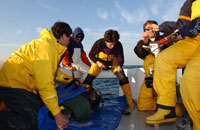 |
| Divers pick out individual fish to be tagged from the holding pen at the end of the trap system. |
 |
| Divers guide a bluefin tuna into the supersized sling. |
 |
| A bluefin tuna is lifted out of the holding pen by crane. |
 |
| The bluefin being measured. |
 |
| Scientist Noureddine Abid from INRH puts a piece of bluefin DNA into a vial. |
 |
| Dr. Block carefully inserts a satellite tag before the fish is released outside of the trap. |




1 comment:
Almadraba's Zahara de los Atunes
The maze of networks that are standing in the sea at a certain distance from the coast for entering almadraba tuna is called .
Comes from the Arabic al- mazraba , double meaning , because although the Spanish word translates fence, also the Arabic root drb- , hitting, so it translates as place or fence where it hits . Normally it is a large network that is a labyrinth , made with fish near the coast , to intercept the passage of migratory species of tuna and tuna . The various pieces of netting are stalled thoroughly, arming them so that they are perpendicular to it . More information in Zahara de los Atunes
Post a Comment